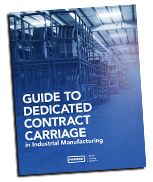Is Your Supply Chain Built for Speed?
How to keep pace with technological advances that build market momentum and supply chain velocity

Time is money, so it pays to complete tasks as quickly as possible. In supply chain management, that involves maximizing velocity—the speed at which products move from the sourcing of raw materials and components to customer delivery and returns.
Increasing supply chain velocity has never been more important, but it can be a formidable challenge for manufacturers. First, it encompasses the numerous sub-processes that add up to an end-to-end supply chain. Second, stepping on the gas can be counterproductive without a commensurate level of control. A faster train delivers goods in less time; if it becomes a runaway train it might not reach its destination.
One way to make the challenge more manageable is to break it down into areas of focus. Knowing where the accelerators are in your operations can make it easier to develop strategies for giving your supply chain more zip.
The Case for Speed
Accelerating the flow of products moving through supply chains delivers competitive advantages on a number of fronts.
High-velocity supply chains require less inventory than their relatively sedate counterparts and are more responsive to shifts in market demand. More speed requires fewer touchpoints, reducing transactional friction and the likelihood of costly mistakes. It's possible to reduce the cost of deploying assets, such as trucks, when companies rev up their supply chains.
In today's fast-paced commercial environment, the need for speed might seem obvious, but that need is becoming greater.
"We are in a period of rising interest rates, which means that inventory is getting more expensive. Shippers want to weed out inventory, whether it is raw materials or finished goods," says Andy Moses, senior vice president of solutions and sales strategy for Penske Logistics.
Another trend that is bolstering the case for ratcheting supply chain velocity is the proliferation of SKUs, Moses says. Companies are introducing more product variants in response to customer demand, and as the number of SKUs rises, so does the level of complexity that has to be managed. Nimbler supply chains are better able to juggle these demand shifts and the product variants they create.
Speed Boosters
How do manufacturers translate the speed imperative into strategies for injecting velocity into their supply chains? Opportunities exist in every area of supply chain management, and to make the task easier, it's sensible to gain an understanding of the main accelerators. Here are some examples:
Agility in planning. The Penske Logistics Glossary defines supply chain planning as the forward-looking process of "making plans to ensure that the right things get to the right place at the right time, ensuring a successful and efficient supply chain that meets demand."
It's a wide-ranging area of activity that covers multiple disciplines, including demand, inventory, and transportation planning. A central theme is the ability to anticipate the need for an asset or service—a truck or an inventory placement, for example—and to plan for its deployment ahead of time. It may be necessary to adjust the plan in line with changing market conditions.
"Better planning is a big piece because it enables us to improve our ability to predict demand and plan for it, and that means less friction in supply chain processes," explains Moses. A current example is the tight market for truck capacity; superior transportation planners are more likely to secure the carriers they need.
A transformative development in this area is the application of artificial intelligence and machine learning technology to increase the accuracy of predictive analytics.
Digitizing data. The rate at which information passes between authorized trading partners is a key determinant of supply chain velocity. Sluggish, inaccurate data flows throw sand into the gears of a supply chain. That is why digitization has become a critical component of velocity-enhancing strategies.
"Tracking the status of orders is one of the myriad tasks we do that benefits from digitization," says Moses. "We are integrating our systems into shippers' digital platforms seamlessly, and improving visibility to goods flows," he adds.
Another important area of activity is developing Application Programming Interfaces (APIs) that enable applications to talk to each other. Penske is in the process of publishing new APIs for shippers and carriers, says Moses.
Network analysis. Optimizing the distribution of nodes in a freight network can add velocity to supply chains. For example, positioning distribution centers closer to customers reduces the number of miles traveled.
Streamlined freight operations. More efficient freight operations smooth the way for product movements. That might entail high-level dynamic routing—changing delivery schedules on the fly—introducing drop trailer programs or improving truck scheduling.
Never-Ending Race
The above list of accelerators is not exhaustive; each manufacturer's supply chain is unique and presents a different set of velocity-related challenges. Also, as Moses points out, cost-versus-service tradeoffs vary from company to company. "A manufacturer may have customer-centric commitments that must to be taken into account," he says.
Still, there is an enduring need to maximize supply chain velocity and keep pace with technological advances that build market momentum.


